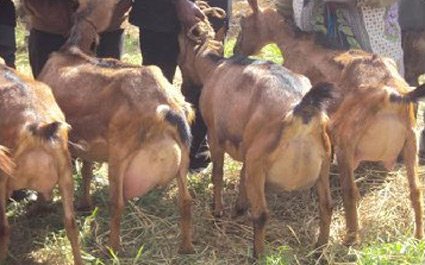Insights on profitable dairy goat farming in Kenya:
The Small East African Goat
These goats occur throughout East Africa, from desert to urban, and are known by tribal or local names.
Their colour ranges from pure white to pure black with various intermixes of roan and speckled brown.
The tassels (toggles) occur in up to 30% of the population. Adult males can weigh 30- 40kg and female’s 25-30kg.
They grow up to a height of 64cm at the shoulders. Both sexes have horns that sweep directly backward and are often curved upwards at the tip.
The horns vary from 2.5 cm to 20cm. The ears are of medium length (approximately 12cm), are slightly pendent and rarely pricked. 40% of the males under 14 months have beards.
The coat is short and fine in both males and females but has longer hair on the hind quarters. The males often have a pronounced mane running the full length of the buck.
They are mainly kept for meat as their milk is rarely enough for one kid. They are useful animals to use as a base in an upgrading program.

The Small East African Goat (Male)
Galla
The Galla goat is indigenous to Northern Kenya. It is also known as the Boran or Somali goat. It’s the milk queen of Kenya’s arid and semi-arid areas.
The female is about 60cm wide at the shoulders and weighs 45-55kgs. The male weighs up to 70 kg. They are white-haired with black skin on the nose (muzzle), feet, and underneath the tail.
Small animal that gives much more than a cow

Galla goat (female)
Another subtype exists that has colour around the neck and lower legs and black stripe down the spine. The females are long-lived and will continue to breed and rear healthy kids up to 10 years of age.
They carry better milk genes and offer greater opportunities for genetic selection for this trait. Their backs are fairly long and slightly dipped.
They are docile and easy to handle, but they do not like cold, wet climates. They thrive best in low altitudes, preferably in acacia bush country.
They have a higher compensatory growth rate after a long dry season. The Galla produces about half a litre of milk per day.
Exotic Breeds
Saanen
This is the milk queen in the goat world. It originated from Switzerland. It’s all white or creamy coloured with pink skin pigmentation.
The face is straight, the ears are upright and alert (pricked) the hair is short and fine and the body is long. As a rule, Saanen does not carry tassels.
Under good management it produces 3-5 litres of milk per day depending on management. They are prolific and have a high twinning rate.
Sometimes the kids are born with both male and female organs (hermaphrodite). This has been observed on polled goats.
Mature male weighs 70-100 kg and mature female weighs 50-70 kg. The female measures 74 -80 cm in height while the mature buck measures 81-92cm. Udders are usually shapely and well attached.
How to make quick cash from the rare and resilient goat breed

Saanen Goats (Notice the pink pigmentation)
Toggenburg
There are two breeds of Toggenburg one originating from Switzerland and the other one from Britain.
The British breed is bigger than the Swiss breed with the female of the British type weighing up to 70kg and bucks up to 100 kg.
With the Swiss type, the female weights are in the range of 50 kg, with bucks up to 70 kg. They are brown or greyish brown in colour with distinctive white stripes on the face and legs.
They may be horned or naturally polled. Horns in males are long and curving back. They may have toggles (tassels) or not. They are very gentle and quiet in temperament.
They are easily handled and can be trained. They have a long body and seem bony. They are bred for milk with average milk yield of 1-3lts per day depending on management.
The breed is suited for the higher cooler regions where heat stress is not a problem and good quality fodder is freely available.

Toggenburg goat (female)
Alpine
The breed originated in the French Alps. They are medium to large in size, hardy and adaptable, and thrive in many climates.
They have a varied coat colour, with shades of grey, brown, black, redbuff, and combinations. Both males and females have a pronounced mane.
They may or may not have horns. The goat is bred for milk, with an average milk yield ranging from 2.5 to 4 lts, subject to management levels.
The Female weighs 50 to 60 kg, while bucks weigh 65 to 80kg. When mature, the female ranges in height from 70 to 76 cm, and the male 80 to 90 cm.
Crosses
There are many crosses depending on the breeds used. Exotic breeds have been crossed with local breeds to produce better-adapted and higher-yielding animals than the local goats.
This is the best starting point for those with local goats who wish to keep dairy goats. The crosses’ performance varies depending on the environment and management.
There are also crosses between the exotic breeds for instance Saanen and Alpine.

Cross-bred goat
Did you love the story? You can also share YOUR story and get it published on Bizna Click here to get started.




